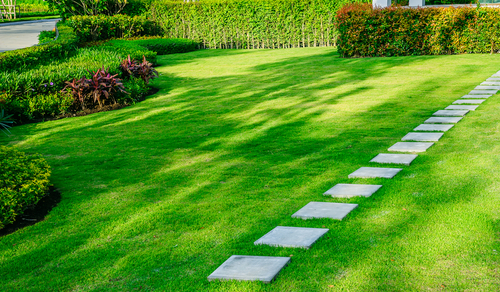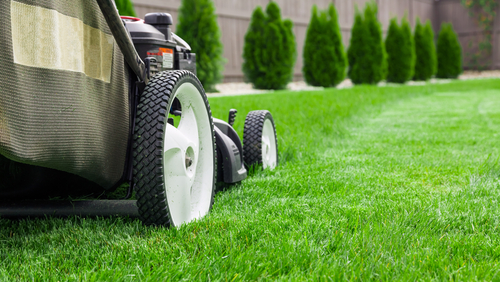The first question to be asked is : Are you using the right species of grass for your needs? A swathe of beautifully healthy and well-maintained lawn adds an inviting and welcoming feel to any property. It does not matter if the property is a private home or commercial premises – a carpet of green grass is always a welcome sight and brings nature into the environment, either to physically enjoy or simply as a frame around the premises. Green is, in itself, a soothing colour which draws attention and creates a sense of emotional relaxation as it indicates verdant growth and the ever-present existence of nature in our busy lives. And let us not forget the importance of grass in our golf-courses!

Are you giving your lawn care the right amount of time?
Lush, healthy and well-maintained lawns are a joy to see, and when they are bordered with well-tended flowerbeds or walkways, they create a sense of luxury which cannot be over-estimated. But it takes time, care and a fair amount of knowledge to keep a lawn looking good at all times. And time is, unfortunately, often our biggest enemy in our efforts to keep our grass looking good. We need to understand what grass species is suitable for our purposes in order to care for it effectively.
There are different species of grass available to choose from
There are different species of grass available in South Africa. These include :
- Bermuda Grass. This is a beautiful species which is one of the most commonly used grasses in South Africa. This grass is able to withstand heavy foot traffic, but will not do well in shady areas. One of its major advantages is that it is indigenous and is therefore well acclimatised to South African conditions.
- Kikuyu Grass. This is probably one of the best-known grasses in use. It grows quickly and thrives in sunny positions, so it is best not planted in shady areas. Kikuyu grass does, however, require regular cutting every week as cutting off more than one third of the grass blades in one mowing will lead to weakening of the grass. This grass is a tough and hardy species and can withstand more than a little abuse and heavy traffic. It grows quickly and does need to be kept in check to avoid it spreading into flowerbeds and onto walkways. It is one of the most easily maintained species and probably one of the most commonly found grass types. Nonetheless, it is susceptible to disease when exposed to prolonged shade and wet conditions. Since it is a fast-growing grass, it requires a fair amount of watering during hot weather. Growth slows during the winter months, and one should be careful in winter-rainfall areas that the lawn does not become waterlogged.
- LM Grass. This, like Kikuyu, has a creeping growth pattern but is far less invasive than Kikuyu. It can tolerate a fair amount of heat stress and drought. It is used in home gardens, office parks, shade areas and on golf courses, but is not suited to high traffic areas due to its soft texture. This grass becomes dormant in winter.
- Gulf Green. Arguably one of the most expensive species of lawn grass, this is also one of the most beautiful due to its deep green colour. This is a soft grass and one of the most pleasant to walk, sit and play on. An added advantage is that this is an indigenous species, so well suited climatically for South Africa.
- Buffalo Grass. This species of grass is suited to both sun and shade, and is a generally hardy grass, well able to withstand heat, cold and drought. It is indigenous to the coastal areas but, conversely, does not do well in sandy soils. It is slower-growing than Kikuyu and only requires mowing once a month. However, due to its slow growth habit, it is more susceptible to weed invasion. It becomes dormant from April to September.
- St Augustine, another shade grass.
- Fescue Grass, also well suited to shady areas.
- Cynadon. This is an excellent grass for drought-prone areas due to its deep root system and fine texture. It is considered invasive as it has a very fast growth habit and can well overtake an existing, slower-growing lawn if not kept in check. This is a tough grass which can withstand high traffic. This grass turns pale yellow in winter during its dormant period but will revert to green once summer returns.
It is therefore easy to see why it is so important to choose the right grass for the area to be covered. Each species has its own advantages and drawbacks, and it pays to do your homework before deciding on which species to use and how it is to be used.
Be aware of those invasive weeds!
One must also remember that, like its floral counterparts, grass is also prone to being attacked by pests and overtaken by invasive weeds.
Very briefly, be on the lookout for weeds such as :
- Dandelions, with their bright yellow flowers, grow year-round and mature plants have a strong taproot which is difficult to dig out. These weeds need to be eradicated early in their growth-cycle with the aid of appropriate herbicides.
- Winter Grass. As its name implies, this weed grows in damp and shady areas, which are particularly prevalent during the winter months. It is distinguishable from its bright green colour and small white flowers.
- Creeping Sorrel. As its name implies, this weed grows horizontally and is identified by its clusters of small yellow flowers.
- Broad leaf weeds. There is a variety of these weeds which establish themselves in lawns and flowerbeds with equal ease.
- Clover. This might actually just be a lucky find in your lawns and flowerbeds, whether four-leaved or the more common three-leaf plant! Clover has a long root system which can extend very deep into the soil – up to 86 cm below ground. Whilst they are annoying to see, Clover does add important nitrogen to the soil, stabilises the soil and attracts pollinators to the garden. Don’t be too quick to remove clover from your lawns!
If you need help with the maintenance and care of your lawn, or are looking to plant a lawn from scratch, consider calling for the specialists before you tackle this job. They will bring one of your home’s or commercial premises’ assets back to full glory and keep it looking good for years to come. For more information, please look at Uptasker’s articles on Lawn Specialists.
